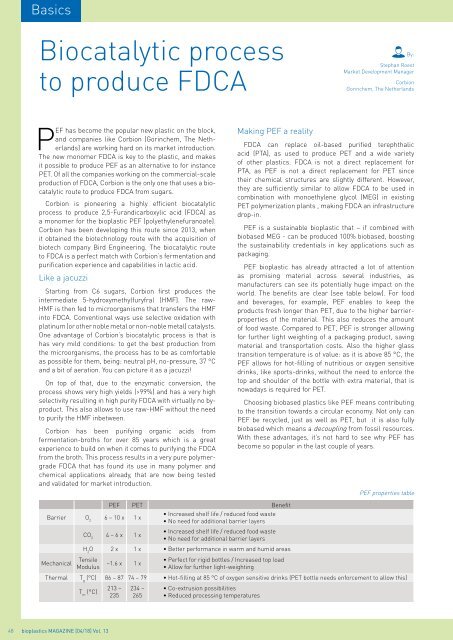Issue 04/2018
bioplasticsMAGAZINE_1804
bioplasticsMAGAZINE_1804
You also want an ePaper? Increase the reach of your titles
YUMPU automatically turns print PDFs into web optimized ePapers that Google loves.
Basics<br />
Biocatalytic process<br />
to produce FDCA<br />
By:<br />
Stephan Roest<br />
Market Development Manager<br />
Corbion<br />
Gorinchem, The Netherlands<br />
PEF has become the popular new plastic on the block,<br />
and companies like Corbion (Gorinchem, The Netherlands)<br />
are working hard on its market introduction.<br />
The new monomer FDCA is key to the plastic, and makes<br />
it possible to produce PEF as an alternative to for instance<br />
PET. Of all the companies working on the commercial-scale<br />
production of FDCA, Corbion is the only one that uses a biocatalytic<br />
route to produce FDCA from sugars.<br />
Corbion is pioneering a highly efficient biocatalytic<br />
process to produce 2,5-Furandicarboxylic acid (FDCA) as<br />
a monomer for the bioplastic PEF (polyethylenefuranoate).<br />
Corbion has been developing this route since 2013, when<br />
it obtained the biotechnology route with the acquisition of<br />
biotech company Bird Engineering. The biocatalytic route<br />
to FDCA is a perfect match with Corbion’s fermentation and<br />
purification experience and capabilities in lactic acid.<br />
Like a jacuzzi<br />
Starting from C6 sugars, Corbion first produces the<br />
intermediate 5-hydroxymethylfuryfral (HMF). The raw-<br />
HMF is then fed to microorganisms that transfers the HMF<br />
into FDCA. Conventional ways use selective oxidation with<br />
platinum (or other noble metal or non-noble metal) catalysts.<br />
One advantage of Corbion’s biocatalytic process is that is<br />
has very mild conditions: to get the best production from<br />
the microorganisms, the process has to be as comfortable<br />
as possible for them, being: neutral pH, no-pressure, 37 °C<br />
and a bit of aeration. You can picture it as a jacuzzi!<br />
On top of that, due to the enzymatic conversion, the<br />
process shows very high yields (>99%) and has a very high<br />
selectivity resulting in high purity FDCA with virtually no byproduct.<br />
This also allows to use raw-HMF without the need<br />
to purify the HMF inbetween.<br />
Corbion has been purifying organic acids from<br />
fermentation-broths for over 85 years which is a great<br />
experience to build on when it comes to purifying the FDCA<br />
from the broth. This process results in a very pure polymergrade<br />
FDCA that has found its use in many polymer and<br />
chemical applications already, that are now being tested<br />
and validated for market introduction.<br />
Making PEF a reality<br />
FDCA can replace oil-based purified terephthalic<br />
acid (PTA), as used to produce PET and a wide variety<br />
of other plastics. FDCA is not a direct replacement for<br />
PTA, as PEF is not a direct replacement for PET since<br />
their chemical structures are slightly different. However,<br />
they are sufficiently similar to allow FDCA to be used in<br />
combination with monoethylene glycol (MEG) in existing<br />
PET polymerization plants , making FDCA an infrastructure<br />
drop-in.<br />
PEF is a sustainable bioplastic that – if combined with<br />
biobased MEG - can be produced 100% biobased, boosting<br />
the sustainability credentials in key applications such as<br />
packaging.<br />
PEF bioplastic has already attracted a lot of attention<br />
as promising material across several industries, as<br />
manufacturers can see its potentially huge impact on the<br />
world. The benefits are clear (see table below). For food<br />
and beverages, for example, PEF enables to keep the<br />
products fresh longer than PET, due to the higher barrierproperties<br />
of the material. This also reduces the amount<br />
of food waste. Compared to PET, PEF is stronger allowing<br />
for further light weighting of a packaging product, saving<br />
material and transportation costs. Also the higher glass<br />
transition temperature is of value: as it is above 85 °C, the<br />
PEF allows for hot-filling of nutritious or oxygen sensitive<br />
drinks, like sports-drinks, without the need to enforce the<br />
top and shoulder of the bottle with extra material, that is<br />
nowadays is required for PET.<br />
Choosing biobased plastics like PEF means contributing<br />
to the transition towards a circular economy. Not only can<br />
PEF be recycled, just as well as PET, but it is also fully<br />
biobased which means a decoupling from fossil resources.<br />
With these advantages, it’s not hard to see why PEF has<br />
become so popular in the last couple of years.<br />
PEF properties table<br />
PEF PET Benefit<br />
Barrier O 2<br />
6 – 10 x 1 x<br />
• Increased shelf life / reduced food waste<br />
• No need for additional barrier layers<br />
CO 2<br />
4 – 6 x 1 x<br />
• Increased shelf life / reduced food waste<br />
• No need for additional barrier layers<br />
H 2<br />
O 2 x 1 x • Better performance in warm and humid areas<br />
Mechanical<br />
Tensile<br />
Modulus<br />
~1.6 x 1 x<br />
• Perfect for rigid bottles / Increased top load<br />
• Allow for further light-weighting<br />
Thermal T g<br />
(°C) 86 – 87 74 – 79 • Hot-filling at 85 °C of oxygen sensitive drinks (PET bottle needs enforcement to allow this)<br />
T m<br />
(°C)<br />
213 –<br />
235<br />
234 –<br />
265<br />
• Co-extrusion possibilities<br />
• Reduced processing temperatures<br />
48 bioplastics MAGAZINE [<strong>04</strong>/18] Vol. 13


















